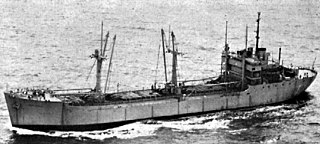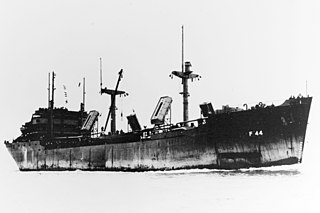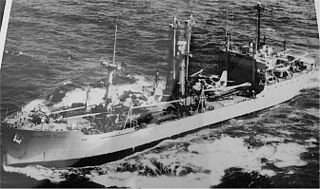USNS Blue Jacket (T-AF-51) was an Alstede-class stores ship in service the United States Navy Military Sea Transportation Service from 1950 to 1971. She was scrapped in 1973.
USNS Blue Jacket (T-AF-51) was an Alstede-class stores ship in service the United States Navy Military Sea Transportation Service from 1950 to 1971. She was scrapped in 1973.
Blue Jacket—a C2-S-B1 type freighter—was laid down under a Maritime Commission contract (MC hull 183) on 23 October 1941 at Oakland, California, by the Moore Dry Dock Co.; launched on 14 February 1942; sponsored by Mrs. Edward U. Read; and delivered to her operators, the United Fruit Co., on 25 March 1943.
During World War II, she was operated by the United Fruit Company, then in 1947 by the Black Diamond Steamship Corporation and, after return to the Maritime Commission in 1948, by the U.S. Army under charter. [1] Blue Jacket was acquired from the U.S. Army in 1950 as a refrigerator ship, T-AF-51, and assigned to the Military Sea Transportation Service (MSTS), Atlantic Area. She operated as such, lifting cargoes of various kinds (mostly consisting of refrigerated stores) between the United States and European ports through the late 1960s. Taken out of service with MSTS on 19 August 1970,
Blue Jacket was transferred on that day to the temporary custody of the Maritime Administration for lay-up in the James River, Virginia. On 1 September 1971, she was transferred to the permanent custody of that agency; and her name was struck from the Navy list on 19 October 1971. Sold to Andy International, Inc., of Houston, Texas, on 1 March 1973, the ship was later scrapped.
Blue Jacket's crew was eligible for the following medals:

USNS Redstone, designated T‑AGM‑20, was a tracking ship assigned to Apollo space mission support under the control of the Eastern Range. For a brief time during conversion the ship was named Johnstown with the designation AGM‑20.
SS Mission Santa Cruz was a Type T2-SE-A2 tanker built for the United States Maritime Commission during World War II. After the war she was acquired by the United States Navy as USS Mission Santa Cruz (AO-133). Later she transferred to the Military Sea Transportation Service as USNS Mission Santa Cruz (T-AO-133). She was a member of the Mission Buenaventura class and was named for Mission Santa Cruz in Santa Cruz, California.

USS Bondia (AF-42) was an Adria-class stores ship in service with the United States Navy from 1945 to 1946 and from 1951 to 1973. She was scrapped in 1974.

USS Laurentia (AF-44) was an Adria-class stores ship in service with the United States Navy from 1945 to 1946 and from 1950 to 1970. She was scrapped in 1973.

USNS Bald Eagle (T-AF-50) was a Maritime Commission type C2-S-B1 cargo ship delivered to the War Shipping Administration (WSA) in May 1943. The ship was operated by WSA agent shipping companies until July 1948 when laid up in the James River Reserve Fleet briefly before beginning operation for the U.S. Army in October. When the Navy's Military Sea Transportation Service (MSTS) took over all military ocean shipping in 1950 the ship was transferred to operate as one of six refrigerated cargo ships in the MSTS fleet until July 1970 as USNS Bald Eagle. The ship was permanently transferred to Maritime Commission custody in September 1971 and sold for scrap in 1973.

USS Arcturus (AF-52) was an Alstede class stores ship stores ship acquired by the U.S. Navy. Her task was to carry stores, refrigerated items, and equipment to ships in the fleet, and to remote stations and staging areas.

USNS Grommet Reefer (T-AF-53) was a Grommet Reefer-class stores ship acquired by the U.S. Navy. Her task was to carry stores, refrigerated items, and equipment to ships in the fleet, and to remote stations and staging areas.

USS Bellatrix (AF-62) was an Alstede-class stores ship in service with the United States Navy from 1961 to 1968, following commercial service from 1945 to 1961. She was scrapped in 1969.

The SS Arcadia Victory was a Victory ship built during World War II for cargo shipping. She was launched by the California Shipbuilding Company on 1 July 1944 and completed on 22 September 1944. The ship's United States Maritime Commission designation was VC2- S- AP3, hull number 41.

USNS Perseus (T-AF-64) was a Denebola-class stores ship acquired by the U.S. Navy. Her task was to carry stores, refrigerated items, and equipment to ships in the fleet, and to remote stations and staging areas.

USS Maquoketa (AOG-51) was a Patapsco-class gasoline tanker in service with the United States Navy from 1945 to 1947 and with the Military Sea Transportation Service from 1952 to 1957. She was sold for scrap in 1975.
USS Muskingum (AK-198/T-AK-198) was an Alamosa-class cargo ship that was constructed for the US Navy under a US Maritime Commission (MARCOM) contract during the closing period of World War II. She supported the end-of-war Navy effort. On 7 March 1946 Muskingum was placed in service under bareboat charter with the US Army under the Shipping Control Authority for the Japanese Merchant Marine with a Japanese crew. In 1950, she was reactivated and placed into service with the Military Sea Transportation Service as USNS Muskingum (T-AK-198) until being struck from the Navy list in 1973. She was ultimately transferred to the Trust Territory of the Pacific Islands (TTPI) and the Republic of Palau.

USS Pembina (AK-200) – later known as USNS Pembina (T-AK-200) -- was an Alamosa-class cargo ship that was constructed for the U.S. Navy during the closing period of World War II. She supported the end-of-war Navy effort and was subsequently placed in service with the US Army under the Shipping Control Authority for the Japanese Merchant Marine with a Japanese crew in Yokosuka, Japan.

USNS Sgt. Archer T. Gammon (T-AK-243) was a Boulder Victory-class cargo ship built at the end of World War II and served the war and its demilitarization as a commercial cargo vessel. From 1946 to 1950 she served the U.S. Army as a transport named USAT Sgt. Archer T. Gammon. In 1950 she was acquired by the United States Navy and assigned to the Military Sea Transportation Service. In 1973 she ended her career and was struck and scrapped.
USNS Capt. Arlo L. Olson (T-AK-245) was a United States Maritime Administration C1-M-AV1 type coastal cargo ship constructed as Bell Ringer for the Administration, completed in August 1945 and placed in operation by the War Shipping Administration under its agent, Waterman Steamship Company, until August 1946. The ship was then transferred to the Army under bareboat charter, The Army renamed the ship Capt. Arlo L. Olson, for Captain Arlo L. Olson who was awarded the Medal of Honor in World War II. The ship was among the Army ships transferred to the Navy in 1950 and then operated by the Military Sea Transportation Service as USNS Capt. Arlo L. Olson with hull number T-AK-245 until 1958.

USNS Colonel William J. O’Brien (T-AK-246) was a US Maritime Administration (MARCOM) C1-M-AV1 type coastal cargo ship, originally planned as an Alamosa-class cargo ship. Constructed as Maiden's Eye for the MARCOM, completed in August 1945 and placed in operation by the War Shipping Administration (WSA). After the war Maiden's Eye was transferred to the US Army and renamed USAT Colonel William J. O’Brien who kept her in service until transferred to the US Navy in 1950 for operation as USNS Colonel William J. O’Brien (T-AK-246) by the Military Sea Transportation Service (MSTS) until 1973.
USNS Sgt. Truman Kimbro (T-AK-254) was a Boulder Victory-class cargo ship built for the U.S. Maritime Commission during the final months of World War II as the SS Hastings Victory.

USNS Maumee (T-AO-149), later T-AOT-149, was a United States Navy Maumee-class oiler, later transport oiler, in non-commissioned service with the Military Sea Transportation Service (MSTS), later Military Sealift Command, from 1956 until probably the mid-1980s.
USNS Flyer (T-AG-178), was a type C2-S-B1 cargo ship of the United States Navy, built for the Maritime Commission (MC) as Water Witch in service under charter by the Commission to several lines until purchased in 1946 by United States Lines and renamed American Flyer. After being placed in the Reserve Fleet 14 December 1964 the title was transferred to the Navy for use as a deep ocean bathymetric survey ship supporting installation of the Sound Surveillance System (SOSUS). The Navy placed the ship in service 9 February 1965 with the name Flyer given on 22 March. The ship operated in that role until 1975.

USNS Marine Adder (T-AP–193) was a troop ship for the United States Navy in the 1950s. She was built in 1945 for the United States Maritime Commission as SS Marine Adder, a Type C4-S-A3 troop ship, by the Kaiser Company during World War II. In 1950, the ship was transferred to the Military Sea Transport Service of the U.S. Navy as a United States Naval Ship staffed by a civilian crew. After ending her naval service in 1957, she entered the National Defense Reserve Fleet, but was sold for commercial use in 1967. She was used in part to carry supplies to support the Vietnam War efforts. During the summer of ‘72 while in Da Nang harbor, South Vietnam a limpet mine was attached to the hull by a swimmer. The mine blew a hole in the hull. In order to save the ship the Skipper ran it aground in Da Nang harbor. The USS Navy standby salvage ship USS Grasp with its crew of divers installed a box patch over the hole and pumped the water from the bilges, before moving the ship to a pier. US Army tanks hung from ship booms to heel the ship so that a metal patch could be welded in place to return the ship to duty. SS Transcolorado, she was chartered by the Military Sealift Command as a civilian cargo ship designated T-AK-2005.